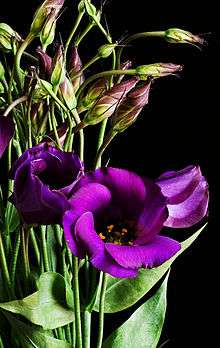Eustoma
Eustoma, commonly known as lisianthus or prairie gentian,[1] is a small genus in the gentian family. They are native to warm regions of the southern United States, Mexico, Caribbean and northern South America.[2] This genus is typically found in grasslands and in areas of disturbed ground.
| Eustoma | |
|---|---|
 | |
| Eustoma russellianum | |
| Scientific classification | |
| Kingdom: | Plantae |
| Clade: | Tracheophytes |
| Clade: | Angiosperms |
| Clade: | Eudicots |
| Clade: | Asterids |
| Order: | Gentianales |
| Family: | Gentianaceae |
| Tribe: | Chironieae |
| Subtribe: | Chironiinae |
| Genus: | Eustoma Salisb. (1806) |
| Species | |
Description
They are herbaceous annuals, growing to 15–60 cm tall, with bluish green, slightly succulent leaves and large funnel-shaped flowers growing on long straight stems: sometimes erect single stems, other times growing on branching stems that can rise to be eighteen feet tall. The flowers can grow up to two inches across and can be found in a variety of colors. They have been found in all shades of pink, purple, white, and blue. In addition, some are bicolored and some are occasionally found in yellow or carmine-red.
Eustoma flowers are either single-flowered or double-flowered. Both types of flowers can be found in all ranges of the possible colors listed above.[3] They are usually one to three feet tall, although there are dwarf varieties that only grow up to eight inches in height.[4]
Taxonomy
Eustoma is a small genus, containing only two or three species.[5]
The genus name Eustoma is a compound of the Greek prefix ευ- ( eu- ) 'good / pleasing' and Greek στόμα ( stoma ), 'mouth' - hence '( having a ) pleasing mouth', while the obsolete Lisianthus is a compound of λισσος ( lissos ) 'smooth', and ανθος ( anthos ) 'flower'.
Cultivation
Eustoma are a beautiful, high-end cut flower, but they are tricky to grow and require some maintenance.[6] They have tiny seeds that must be sown on the surface, not buried,[3] and they must be planted in rich, well-drained soil and exposed to full sun. They must be kept moist but not overwatered: overwatering may result in the growth and development of fungal diseases.[6] Careful control of temperature is necessary to prevent rosetting[3] and cultivation under cover is recommended to prevent spotting on the petals[7]. Lisianthus flowers will begin to bloom in early summer and some will continue to bloom throughout the later months of the summer. When cut, Lisianthus flowers can last anywhere from two to three weeks in a vase.[6]
Eustoma russellianum is particularly popular and has a number of cultivars that are grown for the cut-flower market.
References
- ITIS Standard Report Page: Eustoma
- "Eustoma world origins". 2013-02-22. Archived from the original on 2013-05-16. Retrieved 2013-03-18.
- "Lisianthus." Cornell University College of Agriculture and Life Sciences. Cornell University. Web. 4 Aug. 2020
- "Eustoma Grandiflorum" Missouri Botanical Garden. Missouri Botanical Garden, n.d. Web. 11 Dec. 2012
- "Flora of the Southern and Mid-Atlantic States".
- "Lisianthus" Better Homes and Gardens. Better Homes and Gardens, n.d. Web. 11 Dec. 2012
- "Lisianthus (Eustoma grandiflorum) | Growing Instructions | Technical Production Guide". www.johnnyseeds.com. Retrieved 2020-08-04.